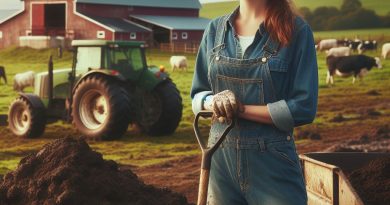Wind Energy: Revolutionizing Farming
Last Updated on January 27, 2024
Introduction
In the context of farming, wind energy plays a significant role in revolutionizing the agricultural industry.
With its numerous benefits, wind energy has become increasingly popular.
Wind energy is the harnessing of the wind’s power to generate electricity or mechanical energy.
It is a renewable and clean source of energy, meaning it does not contribute to greenhouse gas emissions or air pollution.
The significance of wind energy in farming lies in its ability to provide a sustainable and reliable source of power.
Farmers can utilize wind turbines to generate electricity, reducing their reliance on non-renewable energy sources.
By harnessing wind energy, farmers can reduce their carbon footprint and contribute to a greener future.
Furthermore, wind energy can help farmers save costs, as they can potentially generate excess electricity and sell it back to the grid.
In addition, wind energy can enhance the efficiency of farming operations.
For instance, wind turbines can power irrigation systems, reducing the need for manual labor and increasing productivity.
Moreover, wind energy can facilitate the adoption of advanced technologies in agriculture.
Energy generated from wind can power precision farming techniques like automated monitoring systems and drones, allowing farmers to optimize crop growth and increase yields.
In short, wind energy is revolutionizing farming by providing a sustainable, cost-effective, and efficient source of power.
Its environmental benefits, along with the potential for technological advancements, make wind energy an invaluable asset to the agricultural industry.
The Basics of Wind Energy
Wind energy is an increasingly popular form of renewable energy that is revolutionizing farming practices.
In this section, we will explore the basics of wind energy and how it is being utilized in farms across the world.
How wind energy works
Wind energy is generated by the conversion of the wind’s kinetic energy into mechanical power.
As the wind blows, it causes the blades of a wind turbine to rotate.
This rotation activates a generator, producing electricity.
Overview of wind turbines and their components
Wind turbines consist of several key components. The tower is a tall structure that supports the turbine and places it at a height where it can catch the strongest winds.
The blades, usually made of fiberglass or carbon fiber, capture the wind’s energy.
The nacelle houses the generator, gearbox, and other essential machinery.
The process of harnessing wind energy on farms
To harness wind energy on a farm, several variables are considered.
First, the wind resource potential of the area is evaluated to determine if it is suitable for wind power generation.
Once determined, turbines are strategically placed to optimize wind capture.
The electricity generated can supply power directly to the farm or be sent to the grid.
To further understand wind energy, here are some interesting facts:
- Wind energy is one of the fastest-growing sources of electricity globally, with a 19% increase in capacity in 2019.
- One wind turbine can generate enough electricity to power around 1,500 homes.
- Wind energy is a clean source of power, producing no air or water pollution.
- Farmers can lease their land for wind farms, providing additional income and diversifying their operations.
- Wind turbines have a lifespan of about 20-25 years and require regular maintenance to ensure optimal performance.
Benefits of wind energy in farming
- Lower energy costs: Harnessing wind energy can significantly reduce energy costs for farmers by providing a reliable and affordable source of electricity.
- Sustainable farming practices: Wind energy aligns with sustainable farming practices, allowing farmers to reduce their carbon footprint and contribute to a cleaner environment.
- Diversification of income: By leasing their land for wind farms, farmers can diversify their income streams and stabilize their finances.
- Community development: Wind energy projects on farms often lead to job creation and economic growth in rural communities.
Challenges and considerations
While wind energy brings numerous benefits, there are some challenges and considerations to be aware of:
- Initial investments: Setting up wind turbines requires a significant upfront investment, which can be a barrier for some farmers.
- Land and space requirements: Wind turbines require adequate spacing to avoid turbulence and optimize wind capture, which may limit their installation on smaller farms.
- Noise: Wind turbines can produce noise, although modern designs have significantly reduced this issue.
- Visual impact: Some people find wind turbines visually intrusive, which could lead to opposition or concerns from nearby communities.
In face, wind energy is revolutionizing farming by providing a sustainable and cost-effective source of electricity.
By harnessing the power of the wind, farmers can reduce their carbon footprint, lower energy costs, and contribute to the growth of renewable energy.
While challenges exist, the benefits of wind energy in farming far outweigh the drawbacks.
Read: Solar Power Boosts Farms: A Bright Future
Advantages of Wind Energy in Farming
Wind energy is revolutionizing farming by providing numerous benefits to farmers.
Here are some advantages of using wind energy in farming:
Overview of the benefits of wind energy to farmers
- Increased sustainability and reduced reliance on non-renewable energy sources.
- Cost-effective electricity generation leading to significant savings for farmers.
- Contribution to a cleaner environment and reduced carbon emissions.
- Independence from the grid, ensuring stable electricity supply even in remote farming areas.
- Support for the local economy through job creation and additional revenue streams.
Reduction of electricity costs and dependence on the grid
Farmers often face high electricity costs due to the energy-intensive nature of their operations.
However, harnessing wind energy can significantly reduce these costs by utilizing a free and abundant resource.
By installing wind turbines on their land, farmers can generate their own electricity and become less reliant on the grid.
This not only saves money but also provides a consistent power supply, even during power outages or grid failures.
Renewable and sustainable energy source
Wind energy is a renewable and sustainable energy source that does not deplete the Earth’s finite resources.
Unlike fossil fuels, which contribute to air pollution and climate change, wind power produces clean and green energy.
By utilizing wind turbines, farmers can align their operations with the principles of sustainability and contribute to a greener future.
Contribution to environmental conservation and reduction of carbon footprint
Wind energy plays a crucial role in environmental conservation. By opting for wind power, farmers can significantly reduce their carbon footprint and greenhouse gas emissions.
Traditional farming methods often involve the use of fossil fuel-powered machinery, which contributes to air pollution and climate change.
By integrating wind energy into their operations, farmers can mitigate these negative impacts and contribute to a cleaner and healthier environment.
In essence, wind energy offers numerous advantages to farmers.
By reducing electricity costs, providing a renewable and sustainable energy source, and contributing to environmental conservation, wind power revolutionizes farming practices.
Embracing wind energy not only benefits individual farmers but also helps create a greener and more sustainable agricultural sector.
Read: Farmers’ Guide: Implementing Agroforestry Systems
Integration of Wind Energy on Farms
In this section, we will discuss the various ways in which wind energy is being integrated into farm operations.
We will also explore case studies of successful wind energy implementation on farms and emphasize the importance of strategic planning for wind turbine placement and maintenance.
Integration of Wind Energy
- On-farm wind turbines are being used to generate clean energy and reduce reliance on traditional power sources.
- Wind turbines can be strategically placed in open fields, taking advantage of the unobstructed wind flow.
- These turbines are connected to the farm’s electrical grid, allowing for direct use of the generated energy.
- Excess energy can be stored in batteries or fed back into the main power grid, earning the farm additional income.
- Some farms are establishing wind co-ops, where multiple farms join forces to invest in and share wind turbines.
Case Studies of Successful Implementation
Let’s explore some examples of farms that have successfully integrated wind energy into their operations:
Case Study 1: Green Acres Farm
- Green Acres Farm installed a wind turbine to power their irrigation systems, reducing their carbon footprint.
- They strategically placed the turbine on a hill to maximize wind exposure and optimize energy generation.
- The excess energy produced is fed back into the main grid, generating revenue for the farm.
Case Study 2: Sunny Skies Ranch
- Sunny Skies Ranch implemented a wind energy system to meet their energy needs and power their farm machinery.
- They conducted extensive research and analysis to identify the most suitable locations for wind turbine placement.
- By strategically positioning the turbines in key areas, they harnessed the maximum wind potential.
- As a result, Sunny Skies Ranch achieved energy independence and significantly reduced their operating costs.
Importance of Strategic Planning
Strategic planning plays a vital role in the successful integration of wind energy on farms:
Optimal Turbine Placement
- Thorough analysis of wind patterns, terrain, and existing farm infrastructure is essential.
- Turbines should be placed in locations that offer consistent and strong wind resources for maximum energy production.
- Proper spacing between turbines minimizes turbulence and improves efficiency.
Maintenance and Monitoring
- Regular maintenance and monitoring of wind turbines are crucial to ensure optimal performance and longevity.
- Farms need to develop maintenance schedules and protocols to address any potential issues promptly.
- Technicians should conduct routine inspections, addressing maintenance needs and performing necessary repairs.
- Effective monitoring systems allow farms to track energy generation, detect malfunctions, and optimize turbine performance.
Community Engagement
- Engaging with the local community is important to ensure successful wind energy integration.
- Open dialogue and transparent communication help address concerns and ensure support for wind energy projects.
- Partnerships with local organizations and educational institutions can also facilitate knowledge sharing and awareness.
In general, the integration of wind energy on farms has proven to be a revolutionary approach.
Through successful implementation, farms can reduce their environmental impact, achieve energy independence, and generate additional revenue.
However, strategic planning for turbine placement and maintenance is crucial for optimal results.
By harnessing the power of wind energy, farms can contribute to a more sustainable future while enhancing their own operations.
Read: Sustainable Landscapes: Agroforestry Essentials

Financial and Incentive Programs
In this section, we will explore the financial incentives and programs that are available to farmers for wind energy projects.
These programs aim to provide monetary support and incentives to encourage the adoption of renewable energy initiatives, particularly wind energy.
Overview of Financial Incentives and Programs
Several financial incentive programs are available to farmers who are interested in investing in wind energy projects.
These programs are designed to assist farmers in the development and installation of wind turbines on their land.
One such program is the USDA Rural Energy for America Program (REAP), which provides grants and loan guarantees to farmers for the purchase and installation of renewable energy systems, including wind turbines.
This program aims to help farmers generate clean energy and reduce their reliance on traditional energy sources.
Another important financial incentive is the investment tax credit (ITC) for renewable energy.
The ITC allows farmers to deduct a percentage of their investment in wind energy projects from their tax liability.
This credit provides a significant financial incentive for farmers to invest in wind energy, as it directly reduces the cost of implementing these projects.
Tax Credits and Grants for Renewable Energy Initiatives
Tax credits and grants play a crucial role in supporting the development of renewable energy initiatives, including wind energy projects.
These incentives help farmers offset the initial costs associated with installing wind turbines and make these projects more financially viable.
The federal government offers several tax credits for renewable energy initiatives, such as the Production Tax Credit (PTC).
The PTC provides a tax credit for each kilowatt-hour of electricity generated from qualified wind energy facilities.
This credit can significantly reduce the overall cost of producing wind energy for farmers.
In addition to tax credits, grants are also available to farmers for renewable energy projects.
The Rural Energy for America Program (REAP) grants provide financial support to farmers for the development and implementation of renewable energy systems, including wind energy.
These grants can cover a portion of the project costs and make it more feasible for farmers to invest in wind energy.
Benefiting Farmers Financially and Spurring Adoption of Wind Energy
Financial and incentive programs play a crucial role in benefiting farmers financially and encouraging the widespread adoption of wind energy.
By offsetting the initial costs and reducing the financial burden, these programs make wind energy projects more attractive and financially viable for farmers.
Firstly, these programs help farmers save on energy costs. By generating clean energy from wind turbines, farmers can reduce their reliance on traditional energy sources, such as fossil fuels.
This translates into lower energy bills and increased energy independence for farmers.
Additionally, the financial incentives provided by these programs can help farmers generate additional revenue.
Excess electricity generated from wind energy projects can be sold back to the grid, allowing farmers to earn income through renewable energy production.
This additional revenue stream can significantly impact the financial viability and sustainability of farming operations.
Moreover, the adoption of wind energy projects can have positive economic impacts on rural communities.
The installation and maintenance of wind turbines create jobs and stimulate local economies.
This further strengthens the financial benefits for farmers and the community as a whole.
In brief, financial and incentive programs play a crucial role in supporting farmers in their adoption of wind energy projects.
By providing grants, tax credits, and other incentives, these programs make wind energy more financially viable for farmers, reduce their energy costs, and generate additional revenue.
Moreover, the adoption of wind energy projects benefits rural communities by creating jobs and stimulating economic growth.
Overall, these programs play a pivotal role in revolutionizing farming through the integration of sustainable and renewable energy sources.
Read: Eco Benefits: Agroforestry and Carbon Sequestration
Potential Challenges and Solutions
Identification of potential challenges in adopting wind energy on farms
- Lack of knowledge and awareness about wind energy technology and its benefits.
- High upfront costs of installing wind turbines that can deter farmers.
- Limited availability of suitable wind resources in certain geographical areas.
- Potential negative impact on agricultural activities and land use.
- Permitting and regulatory hurdles that can delay or prevent the installation of wind turbines.
Addressing concerns related to noise, visual impact, and wildlife
- Optimizing turbine design and placement to minimize noise and visual impact on nearby communities.
- Implementing advanced technology to reduce noise levels generated by wind turbines.
- Installing bird and bat protection measures such as wildlife-friendly turbine designs or radar systems.
- Conducting thorough environmental impact assessments and engaging with wildlife conservation organizations.
Description of possible solutions and successful implementations
Overcoming the challenges associated with wind energy adoption on farms requires innovative solutions and successful implementations.
Here are some examples:
- Awareness and Education: Providing farmers with extensive knowledge about wind energy benefits, financial incentives, and successful case studies can increase their willingness to adopt wind technology.
- Financial Support: Government programs, grants, and subsidies can help offset the high upfront costs of wind turbine installations. Collaborations with private entities can also provide financial support.
- Wind Resource Assessment: Conducting detailed assessments to identify areas with high wind potential and focusing on those regions can ensure maximum energy production and economic viability.
- Integration with Agriculture: Implementing strategies to minimize the impact of wind turbines on agricultural activities, such as placing them on non-cultivable land or utilizing them as part of an agroforestry system.
- Community Engagement: Engaging with local communities, addressing their concerns, and involving them in the decision-making process can foster acceptance and support for wind energy projects.
- Collaboration with Experts: Working closely with environmental scientists, wildlife experts, and conservation organizations to develop mitigation strategies and monitor the impact of wind turbines on wildlife.
- Technological Advancements: Continued research and development efforts to improve turbine design, reduce noise levels, and enhance wildlife-friendly features.
- Policy and Permitting Streamlining: Simplifying the permitting process, establishing clear guidelines, and reducing bureaucratic hurdles can expedite the implementation of wind energy projects.
- International Cooperation: Collaborating with international entities and sharing knowledge and best practices can accelerate the adoption of wind energy in farming globally.
In a nutshell, while there are challenges in adopting wind energy on farms, such as lack of awareness and upfront costs, innovative solutions and successful implementations have demonstrated the potential of revolutionizing farming through wind energy.
By addressing concerns related to noise, visual impact, and wildlife and implementing appropriate measures, farmers can harness the benefits of clean and sustainable wind power for a greener future.
Conclusion
The benefits of wind energy in farming cannot be overlooked.
By harnessing the power of the wind, farmers can reduce their reliance on traditional energy sources and save costs.
Wind turbines can generate clean and renewable energy, contributing to a greener environment.
Additionally, integrating wind energy into farming operations can diversify income streams and provide a stable source of revenue.
It is encouraging for farmers to explore the possibilities of wind energy on their land.
They should consider the financial incentives, such as tax credits and grants, that are available to support the installation of wind turbines.
Furthermore, collaborating with energy companies can bring added benefits, including long-term contracts and maintenance support.
As we look towards the future, the potential of wind energy in revolutionizing farming is immense.
With advancements in technology, we can expect even more efficient and cost-effective wind turbines.
Ultimately, wind energy has the power to transform farming practices, making them more sustainable, profitable, and environmentally friendly.
Therefore, it is crucial for farmers to embrace this clean energy source and pave the way for a greener future in agriculture.


